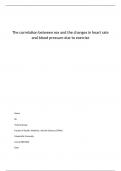The correlation between sex and the changes in heart rate
and blood pressure due to exercise
Name
ID:
Tutorial group
Faculty of Health, Medicine, and Life Sciences (FHML)
Maastricht University
Course BBS1002
Date
, 1 Introduction
When measuring one’s blood pressure, there are two values to consider, first: systolic blood
pressure, which describes to what extent the blood presses against the artery walls during the
heartbeat, and second, diastolic blood pressure, which measures the pressure in the arteries during
the resting period of the heart, in between two beats (1).
Heart rate, which can be defined as the heart’s beats per minute (2), and arterial blood pressure
measurements are widely used since they are a suitable indicator of a person’s health or fitness plus,
they can estimate someone’s risk of cardiovascular disease (3). To measure one’s blood pressure, the
cuff of an automatic sphygmomanometer is wrapped around the arm (or leg) and is inflated to a
higher pressure than the blood pressure of the artery in the arm, causing it to collapse. Then the cuff
will be slowly deflated, until, at a certain pressure, the beat of the artery can be perceived (4). The
outcomes of this measuring procedure are the systolic and diastolic blood pressure values, which are
considered healthy when they are between 90 and 120 mmHg and 60 and 80 mmHg, respectively.
Normal heart rate values lie between 60 and 100 beats per minute (5-7).
Blood pressure and heart rate values are quite diverse for different individuals (4). This might be
related to someone’s age, athleticism, weight, or sex, as there have been clear correlations shown
between blood pressure or heart rate and for instance age or biological sex 8). Women, for example,
in general, have higher resting heart rates than men, but lower blood pressure (8, 9).
On the other hand, heart rate and blood pressure are likely to vary for one individual from moment
to moment, for example, influenced by exercise or stress. With the body’s rising need for oxygen and
nutrients in a state of exercise, heart rate and blood pressure increase as a result (10).
With both exercise and one’s biological sex having a major influence on one’s heart rate and blood
pressure, this study aims to establish whether there is a correlation between biological sex and the
influence exercise has on the heart. More specifically it intends to determine whether changes in
heart rate, systolic blood pressure and diastolic blood pressure due to exercise are correlated to the
biological sex of first-year Biomedical Sciences students at Maastricht University.
So far research has shown evidence that males have a physical advantage when it comes to sport,
thanks to their larger amount of muscle mass and their higher testosterone levels, so assuming this,
the predictions for this study will be that the difference in heart rate and blood pressure will be lower
in male students, than in female students (11).
2





